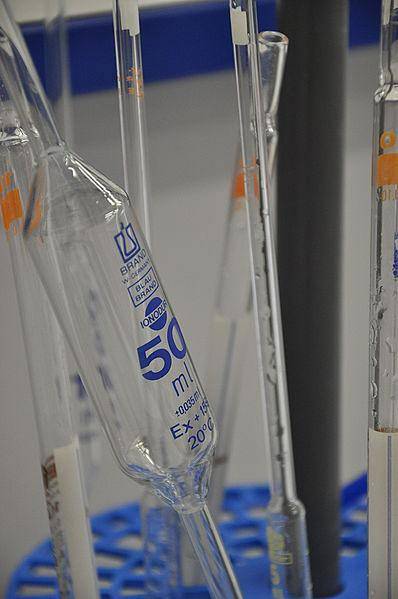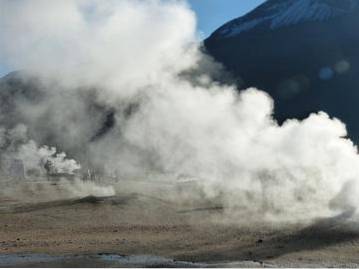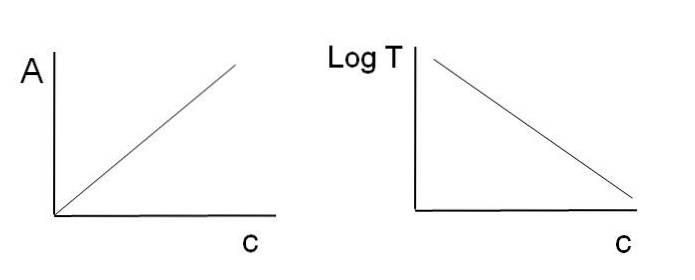
Volumetric pipette features and functions
The volumetric pipette o volumetric is a volume measurement instrument designed to minimize experimental errors. Ensures high accuracy in taking an aliquot of liquid, making it extremely useful in quantitative studies.
The error made when using a volumetric pipette is minimal, as indicated by the following example: with a volumetric pipette of 2 mL capacity, a maximum error of 0.006 mL is made; with a 5 mL volumetric pipette the maximum error is 0.01 mL; and with a 10 mL pipette the error is only 0.02 mL.

That is, if a volume of 2mL is taken, the real value is in the range 2,000 ± 0.006 mL.
In the image above you can see a 50 mL volumetric pipette; there are even 100mL or more, depending on the nature of the analysis. These pipettes ensure accurate transfer of a selected volume of standard solutions or samples; therefore, they are essential in quantitative determinations (how much is there of a chemical species).
Article index
- 1 Characteristics of the volumetric pipette
- 1.1 Physical
- 1.2 Labeling
- 1.3 Calibration
- 1.4 Classification
- 2 Functions
- 3 Difference with graduated pipette
- 4 References
Characteristics of the volumetric pipette
Physical
Volumetric pipettes have an engraved ring at the top called scratch line. If the pipette is filled to this line, and discharged properly, the volume indicated by the volumetric pipette will be poured..
In addition, they have a bulb-shaped dilation in their central part that contributes to the accuracy of the pipettes, since this allows the pipette tip, which ends in a conical shape, to be of a reduced diameter; as well as the upper region of the pipette, precisely where the scratch line is located.
As the region of the graduated pipette where the leveling line is located is small in diameter, it allows the reading of the meniscus of the liquid to be with a minimum error, reducing what is called parallax error.
There are volumetric pipettes with one or two lines of marking: one in the upper part, and another in the lower part of the dilation, close to the conical end of the volumetric pipette..
Flush lines
When volumetric pipettes have a single make-up line, the volume poured is between the make-up line and the end of the tapered pipette tip; whereas if they have two make-up lines, the volume to be poured cannot go beyond the second make-up line, since an error would be made due to excess liquid.
Volumetric pipettes with two flush lines have the advantage that a deformation or break in the conical tip does not affect the accuracy of the volumes poured by the volumetric pipette..
However, since two readings are required to determine the volume poured from the pipette, it can increase the error made when using this instrument..
Lettering
The enlarged part of the volumetric pipette has a set of information about the characteristic of the pipette. In it you can read:
-The manufacturer brand of the pipette.
-The nominal volume of the pipette, for example, if it is 25 mL.
-The maximum error that is made when using the volumetric pipette, in this example is ± 0.03 mL. The reference temperature is generally 20 ºC.
-Other information that appears in the dilated area of the volumetric pipette is the waiting time, usually 5s. That is, after the volume has been transferred, wait 5 seconds before removing the pipette from the receiving container (test tube, beaker, flask, etc.).
-'Ex' means pour calibration; class A or B is an indicator of the error made when using the volumetric pipette; and 'S' means fast emptying.
Calibration
Volumetric materials are calibrated based on the liquid capacity they store (In, per inlet), or the volume they discharge (Ex, discharge).
In
In calibration is generally used for flasks and beakers, but also for pipettes intended for the measurement of viscous liquids (such as syrups, petroleum, suspensions).
The volume reported by the In-calibrated volumetric pipettes is that which is capable of storing; therefore, when measuring with them, they must be completely emptied.
Former
Ex-calibrated materials imply that the volume reported on their labels is the same that they discharge. So, when you have an Ex volumetric pipette, there will always be a small residue that does not count as a measured volume..
To ensure that there is no confusion between said residue and any droplet hanging from the tip of the pipette, it is necessary to discharge all the liquid transferred vertically; then wait a few seconds, and immediately afterwards the tip will slide along the inner wall of the container, to eliminate all traces of droplets.
Classification
Pipettes are classified into class A and class B. Class B pipettes have a maximum permissible or tolerated error that is generally twice that of class A pipettes. Therefore, class A pipettes are considered as more accurate.
Features
Its function is unique: to transfer a volume of liquid measured with maximum precision from one container to another, in order to give it the desired or required use. To do this, it has a set of characteristics that allows it to fulfill this function.
Difference with graduated pipette
-The graduated pipette has a graduated volume scale with a marking of divisions and subdivisions; while the volumetric pipette has a single gauge, and in some cases, two gauges.
-The use of the graduated pipette allows to measure different volumes of liquid, depending on the marking of the pipette. Whereas in volumetric pipettes only the volume indicated on the labels can be measured.
-Its precision and accuracy are higher than those obtained with the graduated pipette.
-Graduated pipettes are classified into serological pipettes and Mohr-type pipettes. Serological pipettes are graduated up to the tip of the pipette, while in the Mohr pipette the graduation of the pipette does not reach the tip.
References
- Vitlab: Competence in Labware. (s.f.). Competence in volume measurement. [PDF]. Recovered from: vitlab.com
- Glossaries. (September 3, 2018). Volumetric pipette. Recovered from: glosarios.servidor-alicante.com
- Wikipedia. (2018). Pipette. Recovered from: en.wikipedia.org
- Flournoy, Blake. (May 15, 2018). What Is the Purpose of a Pipette? Sciencing. Recovered from: sciencing.com
- Seely O. (April 5, 2018). Use of a volumetric pipet. Chemistry Libretexts. Recovered from: chem.libretexts.org



Yet No Comments